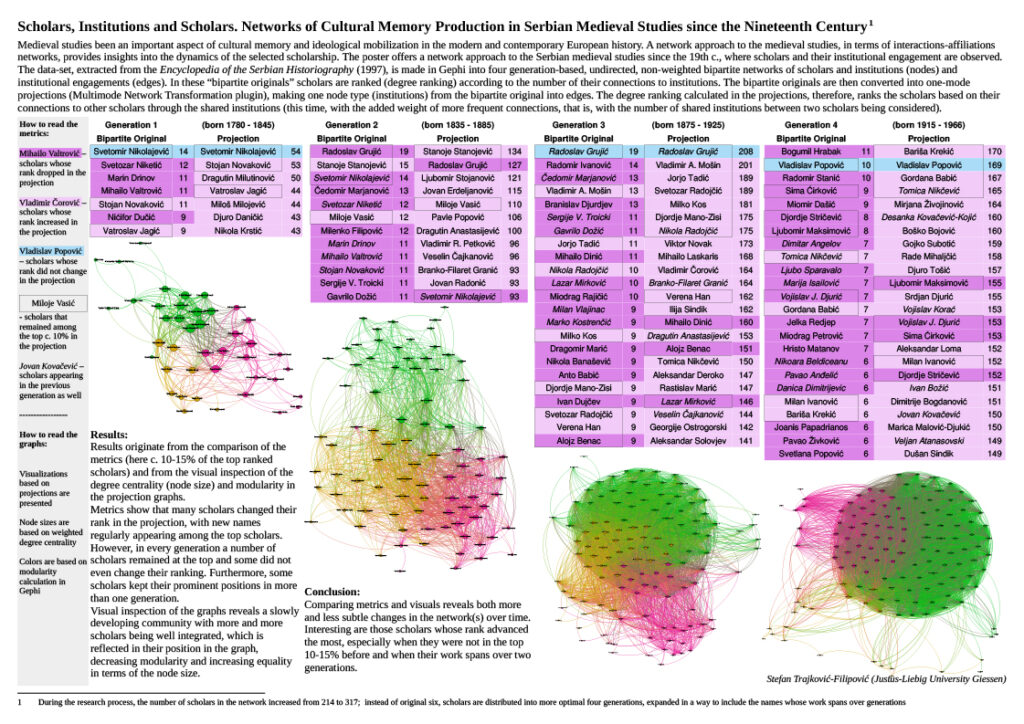Stefan Trajkovic Filipovic
Place and Time: Thursday, 01.07., 16:00–17:00, Room 1
Session: Poster Session – Institutions and Institutionalisation
Keywords: History of scholarship; Serbian medieval studies; Cultural memory; Memory agents; Bi-modal networks; Dual-projection approach
This poster presentation approaches the production of cultural memory of Middle Ages, understood as an entanglement of cultural memory agents – specialist memory makers and institutions (Assmann 2008). Remembering the Middle Ages has been an important aspect of ideological mobilization in the modern and contemporary European history, with scholars acting as distinguished memory makers. The research focuses on medievalists dealing with Serbian medieval history since the nineteenth century, observed as nodes in a network relative to their institutional engagement, providing insights into the dynamics of the selected scholarship and revealing relevant agents contributing to the continuous production of knowledge/cultural memory. The research aims to develop a network model offering a relational perspective on the history of scholarship and complementing other network models.
Data, obtained from the Encyclopedia of Serbian Historiography (Ćirković, Mihaljčić 1997), contains 214 scholars born between 1800 and 1960 and institutions of their education and work. The data-set is further expanded with lists of publishers scholars published with, obtained from bibliographic entries (https://www.cobiss.net/ – regional integrated library catalogs). Starting from the interactions-affiliations networks, approaching actors based on their physical/ideal presence at the same space-time, I work towards a bi-modal network of individuals participating in collective endeavors (Haas, Malang 2010). Data is organized into a relational database, connecting scholars with institutions (work, education, publishing). Distributing the scholars into six generations addresses data’s temporal aspect, offering a balanced distribution (number of scholars steadily increasing over generations). Using Gephi, the database is made into undirected, non-weighted bi-modal networks of scholars/institutions (nodes) and institutional engagements (edges), and further converted into projections with Multimode Network Transformation plugin. Projections turn a bi-modal network into two one-modal networks, making one node type from the bi-modal original into an edge (Everett 2016). I focus on the projection in which institutions become edges, connecting scholars through shared involvement within the same generation. I calculate centrality (degree and weighted degree, as edges gain weight in projections) and visualize communities. The (weighted) degree centrality acts as a local network property, reflecting its importance when basing the quality of edges on theoretical considerations (Mutschke 2010), as well as the individuals’ limited perspective regarding their effect in a network (Lemercier 2011). Communities’ visualizations allow visual inspection and evaluate networks based on their number. Finally, I compare the projection results to the results of the same calculations/visualizations for the bi-modal original.
The research combines a relational database of memory agents with dual-projection approach, offering new perspectives on the dynamics of knowledge/cultural memory production and complementing future/existing network models (e.g. citation network). The poster presents chronologically arranged visualizations for each generation of scholars, both for the bi-modal originals and projections, with corresponding metrics, revealing the differences in centrality/relevance of individual scholars before and after projections. Unlike linear historiography overviews, outlining the significance of selected authorities, this network model distributes the attention on scholars who might not be authorities, but through their institutional engagement and connections to their peers actively participate in the production and dissemination of cultural memory.
References
Assmann, Jan. “Communicative and Cultural Memory.” In: Astrid Erll, Ansgar Nünning (eds.). Media and Cultural Memory. Berlin, 2008.
Ćirković Sima, Mihaljčić Rade (eds.). Enciklopedija srpske istoriografije. Belgrade, 1997.
Everett G., Martin. “Centrality and the dual-projection approach for two-mode social network data.” Methodological Innovations Volume 9/1–8, 2016.
Haas Jessica, Malang Thomas. “Beziehungen und Kanten.” In: Christian Stegbauer, Roger Häußling (eds.). Handbuch Netzwerkforschung. Wiesbaden, 2010.
Lemercier, Claire. “Formal network methods in history: why and how?” in: Social Networks, Political Institutions, and Rural Societies. (https://halshs.archives-ouvertes.fr/halshs-00521527v2)
Mutschke, Peter. “Zentralitätsanomalien und Netzwerkstruktur. Ein Plädoyer für einen ‘engeren’ Netzwerkbegriff und ein community-orientiertes Zentralitätsmodell”. In: Christian Stegbauer (ed). Netzwerkanalyse und Netzwerktheorie: Ein neues Paradigma in den Sozialwissenschaften. Wiesbaden, 2010.
